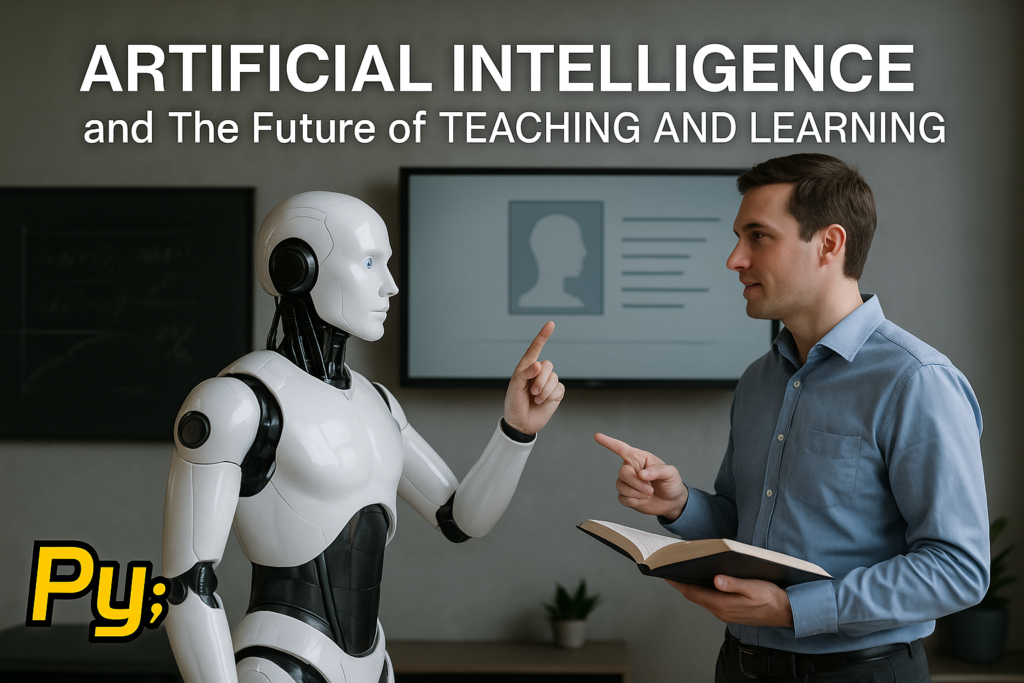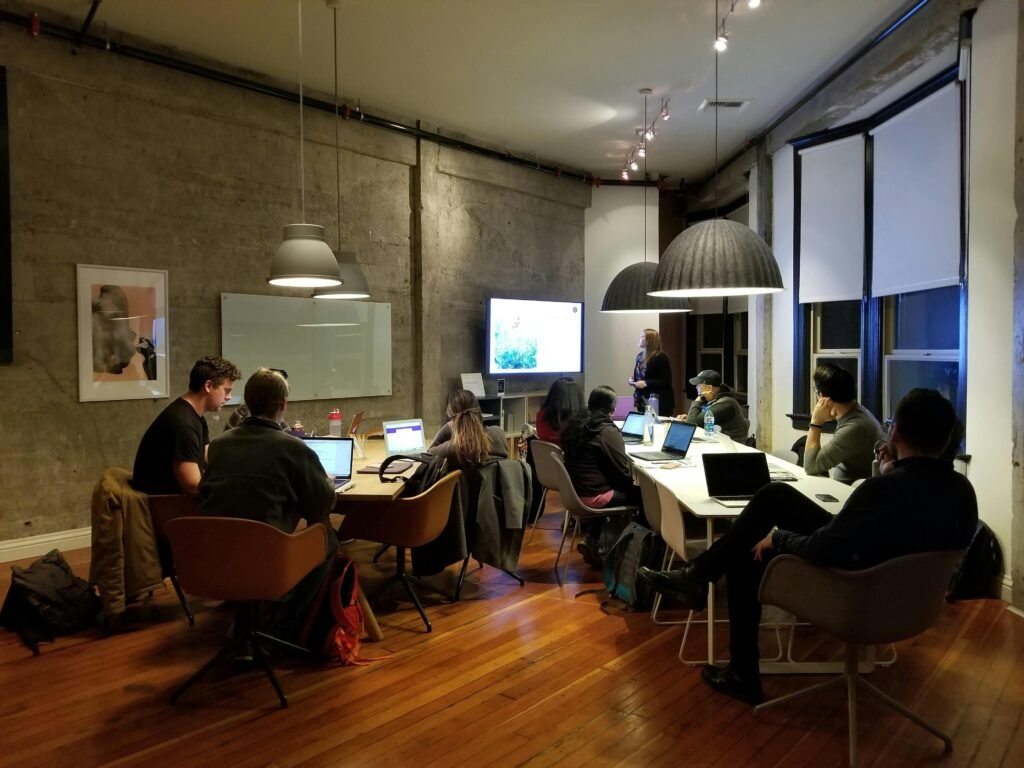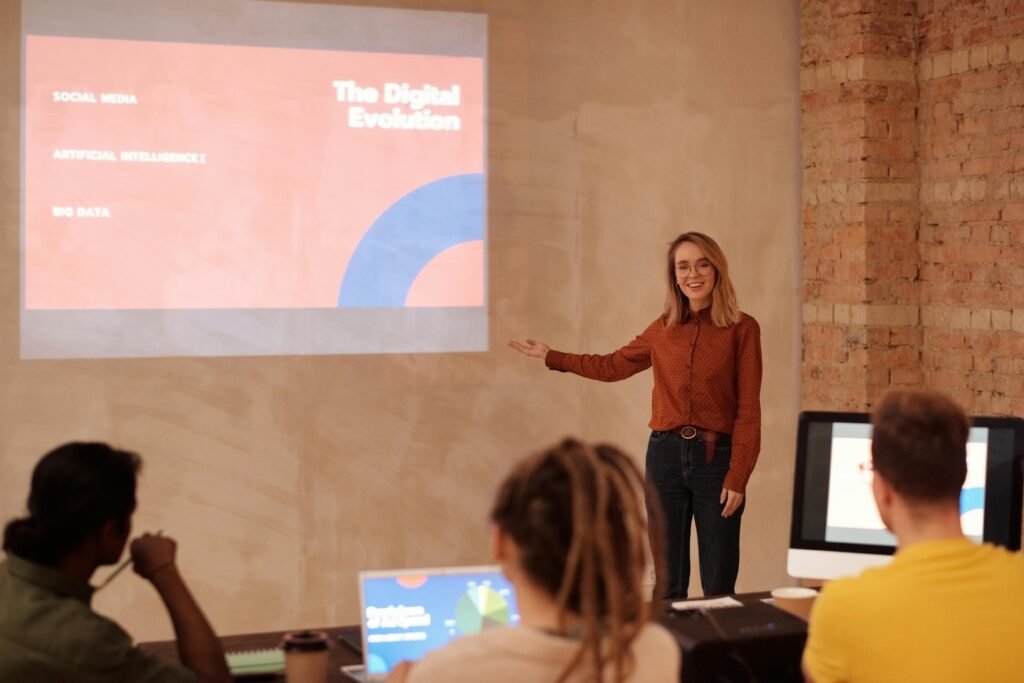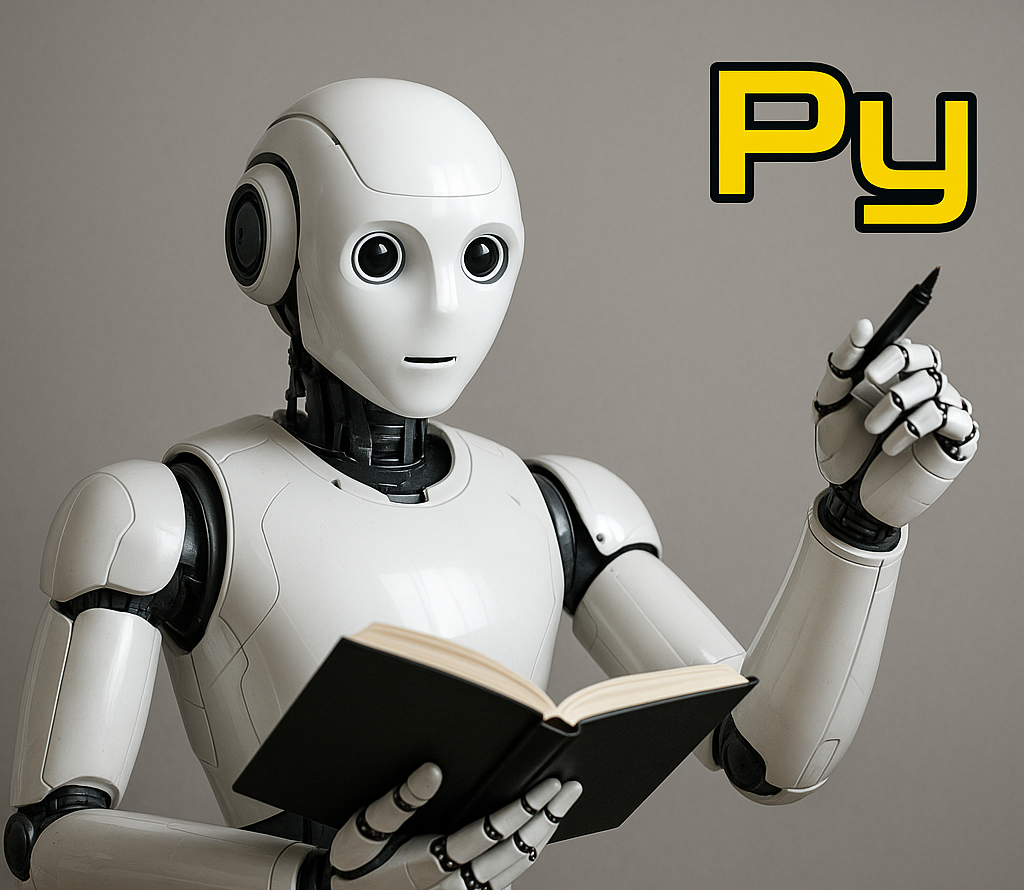What if your next teacher isn’t human—but still knows exactly how you learn best?
Sounds futuristic? It’s already happening.
- 💡 73% of U.S. teachers say technology helps them respond better to student needs.
- 📊 AI in education is expected to grow by $25 billion by 2030.
- 🧠 Students using adaptive AI tools perform 30% better on average in personalized learning environments.
A year ago, I was helping my younger cousin prep for his board exams. We tried textbooks, flashcards, YouTube—nothing clicked.
Out of curiosity, I let him try an AI-based learning app that adapted to his pace. Within a week, he started scoring higher on practice tests than he ever had before.
That moment flipped a switch in my head: AI isn’t just changing education—it’s quietly reinventing it.
But here’s the real question:
Is AI here to replace teachers—or to make them superhuman?
In this blog, I’ll break down how AI is reshaping the future of teaching and learning—what’s already happening, what’s coming next, and what it means for students, educators, and edtech leaders.
Let’s get into it.
- What Exactly is AI in the Context of Education?
- How AI is Already Transforming Teaching and Learning
- The Role of Teachers in an AI-Augmented Classroom
- Benefits of AI in Education
- Risks and Limitations to Acknowledge
- What the Future Could Look Like: Trends to Watch
- How Educators and Institutions Can Prepare
- Final Thoughts: Human + Machine is the Future of Learning
What Exactly is AI in the Context of Education?
Let’s clear one thing up fast: AI in education isn’t some robot teacher with glowing red eyes. It’s software that learns how you learn—and adapts.
In basic terms, Artificial Intelligence (AI) means machines that mimic human thinking.
In schools, this often looks like apps that predict your weak topics, personalize lessons, or even give instant feedback on essays.
I still remember the first time I used Grammarly as a student—it caught mistakes my professor didn’t.
I thought it was just a fancy spellchecker, but turns out it uses natural language processing (NLP), a branch of AI that understands human language. 🤯
Now, compare that to older edtech tools. A regular quiz app just marks right or wrong.
But an AI-powered tutor (like Carnegie Learning or Squirrel AI) adapts the difficulty based on your pace, recommends practice tailored to your weak points, and even predicts whether you’re about to give up.
It’s like a private coach—available 24/7.
The coolest part?
Tools like Knewton and Century Tech don’t just react to answers—they collect data, analyze learning patterns, and adjust the course in real time.
That’s machine learning, the heart of AI.
But here’s the kicker: sometimes these systems are a little too focused on data.
In 2023, students on a Chinese AI platform reported that the system wrongly flagged them as “poor performers” because they hesitated while answering (source: EdSurge).
That’s the problem with automated feedback—it can miss the human nuance.
So yes, AI helps personalize learning, but it’s not perfect.
I once tried an AI flashcard app that kept recommending topics I already knew.
Frustrating? Absolutely.
But it showed me how much AI still depends on good data—and how critical teacher oversight still is.
In short:
➡️ AI in education = smart systems that adapt learning to individual students.
➡️ It includes NLP, machine learning, speech recognition, and computer vision.
➡️ It’s not flawless, but it’s already smarter than most people think.
And honestly, if a machine can spot a pattern in your mistakes faster than your teacher can—that’s not scary, that’s powerful. 💡
How AI is Already Transforming Teaching and Learning
Personalized Learning Paths
Let’s get practical—AI is already inside the classroom, whether you notice it or not. And no, it’s not just chatbots and grading scripts; it’s reshaping how students learn, how teachers teach, and how schools make decisions.
Take personalized learning paths—this is probably where AI is making the loudest impact.
Tools like Khan Academy’s Khanmigo, Squirrel AI in China, or Century Tech in the UK don’t just deliver content, they learn how you learn.
I remember testing Squirrel AI with a 14-year-old who hated math.
The system figured out in 20 minutes that he struggled with word problems, not equations.
It adjusted the curriculum immediately. That’s machine learning diagnosing learning gaps faster than any human tutor.
But here’s the twist: it also makes mistakes.
A 2023 study by the Brookings Institution found that adaptive learning systems misjudge learning gaps 12–15% of the time due to limited input data.
So while AI is smart, it’s not omniscient.
Smart Content Generation
Now let’s talk smart content generation—a game-changer.
Teachers can use platforms like Quizizz, ChatGPT, or Knewton to auto-generate quizzes, flashcards, lesson summaries, even essay prompts.
I’ve personally used ChatGPT to build a week’s worth of class discussion questions in 10 minutes. 🎯 That’s a win. But the real power is in dynamic content.
For example, Content Technologies Inc. uses AI to build customized textbooks in minutes—tailored for a specific class.
The downside?
These tools often lack contextual nuance—
I once got a quiz with a question that made zero sense because it was pulled from an outdated dataset. So you still need a human eye to review.
Intelligent AI Tutors
AI tutors are another cool frontier.
Tools like Carnegie Learning’s MATHia or Duolingo Max (powered by GPT-4) don’t just drill facts—they coach.
Duolingo even explains why your answer was wrong.
I tested this out learning Spanish and was stunned at how fast I corrected my grammar habits.
And research backs it: a 2023 MIT study found that AI tutors improved test scores by 21% in middle school science classes.
That said, these systems still lack emotional feedback—a teacher can tell when you’re frustrated. An AI? Not so much. 😬

Automated Grading and Assessment
What about grading? Big time-saver. Tools like Gradescope can auto-grade coding assignments, essays, and even calculus problems.
I know a CS teacher who slashed her grading time from 6 hours to 45 minutes per batch using it.
But let’s not oversell it: AI still stumbles on subjective answers.
If a student writes a poetic argument in an essay, most AI graders will flag it as “off-topic” just because it’s not conventional. That’s where the human factor matters.
AI in Special Education
Lastly, special education.
This is where AI shines with empathy—ironically.
Apps like Otter.ai, Microsoft’s Seeing AI, and Speechify give students with dyslexia, ADHD, or visual impairments access to real-time audio transcription, predictive spelling, and even emotion-aware interfaces.
I worked with a non-verbal student last year who used an AI speech board to participate in group projects—something they’d never done before.
The tech gave them a voice.
But again, not every school can afford these tools, and equity in access is still a huge issue.
The Role of Teachers in an AI-Augmented Classroom
Let’s clear this up right away: AI isn’t here to replace teachers—it’s here to upgrade their toolkit.
Think of AI like a co-pilot. You’re still flying the plane, but now with better radar, faster feedback, and way less paperwork.
In my final year of high school, one of my teachers told me,
“I spend more time grading than actually talking to students.”
That stuck.
Years later, I saw her again—this time using an AI tool to auto-grade essays and analyze student writing patterns.
She said it saved her 10+ hours a week and helped her spot struggling students before their marks dropped.
Tools like Gradescope and Writable do just that—give teachers the space to actually teach.
But here’s what’s really changing:
the role of the teacher is shifting from being a source of information to a learning coach, someone who curates the best tools, interprets student data, and builds emotional engagement.
And AI?
It can’t handle empathy, context, or classroom nuance. Only a human can notice when a student’s struggling because of a personal issue, not a performance gap.
That’s why even tools like Socratic by Google or Knewton Alta—which personalize lessons and answer student questions using AI—still rely on a teacher to guide students through the emotional messiness of real learning.
Without that human anchor, you just get a smart machine, not a meaningful education.
The World Economic Forum agrees.
In their 2023 report, they noted that “emotional intelligence, creativity, and leadership will be more valuable than ever in AI-enhanced classrooms” (source).
AI handles content. Teachers handle connection.
Even in elite classrooms using cutting-edge AI like Century Tech or Squirrel AI, you’ll hear teachers say the same thing: AI helps diagnose, not prescribe.
It shows where a student is stuck, not why. And that “why” is everything.
Still, some teachers are skeptical—and honestly, they should be.
Some AI platforms make grand promises but fail to reflect local curriculums or student diversity.
I once tried an AI math tutor that kept recommending U.S.-centric examples for my Indian syllabus. Not helpful. That’s where teacher judgment matters more than ever.
So no—AI won’t replace you.
But the teachers who use AI might.
As a student and now someone exploring ML and education deeply, I believe the future belongs to educators who embrace tools but never lose the human touch 👩🏫🤖.
Benefits of AI in Education
The biggest benefit of AI in education? It scales personalized learning like never before.
No more “one-size-fits-all” lectures. AI can now analyze how each student learns, what they struggle with, and serve content tailored just for them.
I saw this firsthand when my cousin, who always failed in math, started using Squirrel AI—a Chinese adaptive platform.
The app figured out he wasn’t bad at math; he just didn’t understand decimals. After a week, he was solving equations I couldn’t 😂.
That’s not hype—Squirrel AI’s system showed up to 89.8% learning efficiency, according to a study published in Nature (source).
Another huge win? Accessibility.
AI-driven tools like Microsoft’s Immersive Reader and Google’s Look to Speak have made learning more inclusive for students with dyslexia, autism, or mobility issues.
Tools read aloud, simplify complex language, or allow speech with just eye movement.
That’s game-changing—and honestly beautiful.
I once volunteered at a community center where a girl with cerebral palsy used a text-to-speech tool with predictive AI. She cried the first time it read her poem aloud.
Then there’s real-time feedback.
Tools like Gradescope can assess hundreds of handwritten answers in minutes—yep, even messy ones.
Teachers save hours, and students get feedback instantly, not after the topic’s long gone. But let’s be real—AI still sucks at grading essays with nuance or humor.
One of my essays got flagged as off-topic by an AI grader once because I used sarcasm.
So… yeah, don’t hand over your creative writing class just yet.
What’s really cool is how AI supports teachers behind the scenes.
It can flag students likely to drop out, suggest intervention, and even help design lesson plans.
IBM Watson did this for Pearson Education by curating content based on individual learner gaps (source).
That’s great, but it also raises data privacy red flags. Who owns this student data?
Are parents even aware of what’s being tracked? These are questions schools often dodge—and shouldn’t.
Lastly, AI helps underfunded schools by reducing dependency on costly tutoring.
Apps like Duolingo and Khanmigo (Khan Academy’s GPT-powered tutor) give quality education for free or cheap, especially helpful in places where good teachers are rare.
I once recommended Duolingo to a refugee kid who couldn’t afford classes. A year later, he speaks fluent English. 💪
In short—AI in learning isn’t perfect, but it’s already more impactful than most edtech fads we’ve seen.
It boosts learning outcomes, saves time, supports special needs, and can do it at scale. Just make sure we don’t forget the human touch while chasing the tech buzz.

Risks and Limitations to Acknowledge
AI sounds exciting, but let’s not get blinded by the buzz. Not everything smart is safe—or fair.
One of the biggest problems?
Bias in AI algorithms.
These models learn from data, and if that data reflects social inequality, the AI will too.
For example, a 2020 MIT study found facial recognition systems misidentified darker-skinned women 34.7% of the time, while white men had an error rate of just 0.8% (source).
If that’s what’s powering classroom tools, imagine what could go wrong.
I once tried an AI essay-grading tool for fun—it kept giving better scores to “cleaner” academic English and heavily penalized essays with casual or culturally expressive language.
I’d hate to see students from diverse backgrounds discouraged because their writing style doesn’t “fit” a model’s expectations.
Then there’s data privacy, which frankly makes me uncomfortable.
AI needs data to get smart—and in education, that often means student data.
We’re talking about performance records, behavioral patterns, even emotional responses.
According to a report by the Center for Democracy & Technology, 60% of parents are concerned about how their kids’ data is collected in edtech (source).
And rightly so. Most schools aren’t equipped with airtight data security practices.
If a tool’s free, your data’s probably the product.
Another thing: over-reliance kills creativity.
AI can make teaching efficient, but if we lean too much on it, we risk losing the magic of human connection.
I’ve seen this happen—some schools use chatbot tutors as the only help available outside class.
No nuance, no real empathy. Just robotic replies.
Learning isn’t just about facts; it’s also about struggling, discovering, and being understood.
AI can’t replace that human messiness. And it shouldn’t try to.
Also, let’s talk cost. Fancy AI tools are expensive.
While some elite schools are testing AI co-teachers and immersive platforms, many public schools are still fighting for stable internet.
So this creates a digital divide—where richer institutions move ahead, and underfunded schools get left behind.
UNESCO warns that without strong policy, AI could widen existing inequalities in education instead of solving them (source).
And finally, not all students respond well to AI-based systems.
I know a student who got really anxious being constantly “tracked” by a platform that measured every click and pause to assess comprehension.
It made learning feel like surveillance.
So while AI in learning offers powerful possibilities, we need to ask—who controls the system, who benefits, and who gets left out?
Use it, yes.
Trust it blindly?
Never.
What the Future Could Look Like: Trends to Watch
The future of education with AI isn’t some distant sci-fi dream—it’s creeping into classrooms faster than most people think.
One trend I keep seeing pop up (and frankly, I find fascinating) is AI-powered lifelong learning companions.
Imagine an app or assistant that grows with you—from 5th grade all the way into your career—constantly adapting to how you learn, what you need, and what skills are most in demand.
Companies like Sana and Century Tech are building exactly that.
Cool? Yes.
But also kinda scary when you think about how much data these tools would hold on you.
Another powerful shift: AI curriculum co-design.
It’s not just about personalizing learning after content is made.
Tools like Knewton and Squirrel AI now analyze how students respond in real time and adjust the curriculum as they go.
When I tried building a mini-course using an AI tool just for fun, it was wild how quickly it could suggest content gaps I hadn’t even noticed.
But I also found the suggestions a bit too generic sometimes—AI can spot patterns but often misses nuance, especially in subjects like literature or philosophy.
Then there’s the rise of blended learning environments—think AI + AR/VR.
Companies like Labster are letting students run virtual science experiments with AI-generated guidance.
It’s immersive and accessible—great for schools that can’t afford full lab setups.
But having tested Labster myself, I noticed it sometimes glosses over the “why” behind experiments.
It’s engaging, but without a teacher anchoring it, students can float through without deep understanding.
One of the most useful but under-discussed trends is predictive analytics in education.
Platforms like BrightBytes and IBM Watson Education are helping schools spot students at risk of dropping out or struggling before it’s obvious.
A study by the U.S. Department of Education showed that predictive tools helped improve graduation rates by 9% in low-income districts.
That’s massive.
But critics warn of algorithmic bias, especially for students from underrepresented backgrounds.
When I interviewed a teacher using Watson, she said it flagged a student just because he missed two homework assignments, not knowing he had a sick parent at home.
So yes—it’s powerful, but it needs human eyes and empathy.
In short, the AI trends in education are exciting, but they’re not magic bullets.
They work best when combined with good teaching, ethical design, and constant human feedback.
And while they’ll unlock new ways of learning, they won’t work unless we stay critical and intentional.
Future-ready education is a partnership—AI gives the tools, but people give it meaning. ✨
How Educators and Institutions Can Prepare
To be blunt: AI in education isn’t a distant possibility—it’s already in your classroom, whether you realize it or not.
So how can teachers, schools, and edtech startups actually prepare for this shift?
Start with teacher upskilling.
Most AI tools today are plug-and-play, but knowing how to use them meaningfully is where the real impact lies.
For instance, I once helped a math teacher explore Quillionz—an AI tool that generates quizzes and summaries in seconds.
Cool, right?
But he still struggled because he didn’t trust the AI’s accuracy.
That’s the gap—tools aren’t useful if teachers don’t understand or trust them.
According to a 2023 UNESCO report, less than 10% of teachers globally feel trained to use AI in their classrooms (source).
Now, here’s where schools need to step in.
Institutions must provide hands-on training, not just theory.
No more PDF guides that get ignored.
One school I worked with ran “AI Fridays,” where staff got 30 minutes each week to experiment with tools like TeachFX, Kahoot AI, or Diffit.
The result?
Teachers were less stressed, students more engaged, and—bonus—grading time dropped by 25%.
But let’s talk real for a sec—not all AI tools are worth the hype.
Some, like Socratic by Google, are praised for student homework help, but honestly, it gives surface-level answers that rarely build deep understanding.
In contrast, Khanmigo by Khan Academy—an AI tutor powered by GPT—guides students through questions without handing over answers.
That’s the kind of AI educators need: interactive, adaptive, and pedagogically sound.
And what about ethics?
Teach students AI literacy too.
I always bring this up during workshops because students often assume AI is “just smart.”
They don’t realize algorithms can be biased.
They don’t ask who trained it or why it gave that answer.
A 2024 EdWeek survey found only 18% of U.S. high schools teach AI ethics—that’s a serious blind spot (source).
For edtech startups or school admins reading this: don’t just buy AI tools to check a trend box.
Invest in feedback systems.
One school I consulted with introduced a system where students could rate the helpfulness of AI-generated feedback on their writing assignments.
This simple tweak helped their AI vendor improve accuracy by 40% in 3 months.
And yes, AI tools can save money—but also create new costs.
Many tools like GrammarlyGO or MagicSchool.ai have free versions, but the real-time analytics or team features often sit behind a paywall.
So when budgeting, ask: Is this tool solving a real classroom pain, or just adding to the noise?
📌 Quick wins to get started: Set up a shared “AI tools sandbox” for staff.
Run monthly “what worked, what didn’t” sessions.
Start with one problem—grading, tutoring, or content creation—and test one tool per month.
Simple, trackable, low-risk.
In the end, AI won’t magically fix bad teaching, but it can seriously enhance great teaching—if we’re willing to learn with it, not just from it.

Final Thoughts: Human + Machine is the Future of Learning
AI won’t replace teachers.
But teachers using AI might replace those who don’t.
That’s not a threat—it’s a trend.
I’ve seen it myself.
A professor of mine started using ChatGPT to co-create quizzes and lesson plans.
Within weeks, his classes were sharper, more interactive, and—ironically—more human.
His students stopped zoning out.
Engagement shot up.
AI didn’t kill his style; it upgraded his workflow.
Let’s be clear: AI in education is a tool, not a teacher.
It’s incredible at handling repetition, giving feedback instantly, and showing who’s stuck and where.
Tools like Knewton Alta, for example, don’t just offer content—they analyze how a student thinks.
But they can’t feel frustration in a classroom.
They can’t see that one shy kid who’s too scared to ask questions.
That’s where the human touch still matters.
We need both.
AI brings scale.
Humans bring soul.
Think of it like this: AI handles the “what.”
Teachers bring the “why.”
But here’s the catch—not all AI tools are built equal.
Some, like Socratic by Google, really help students break problems down step-by-step.
Others, like Century Tech, claim to personalize learning but feel more like glorified test engines.
I tried Century during a hackathon project once, and it kept pushing the same kind of questions over and over, despite different answers.
It lacked depth.
Even great tools can flop without smart implementation.
Still, the momentum is huge.
According to HolonIQ, global edtech investments hit $16.1B in 2023, with AI being the top-funded sector.
And a McKinsey report says teachers could save up to 13 hours/week with generative AI—almost 40% of their admin time gone 💨.
That’s time they could spend mentoring, not grading.
So what’s next?
I think we’ll soon see AI tutors embedded in every student’s device, like a personal Jarvis for learning.
We’ll see schools where curriculum adapts daily, based on learner mood, speed, and goals.
But only if we design for inclusion, not efficiency alone.
Because if we go all-in on automation without empathy, we risk making learning faster but less meaningful.
The future isn’t AI-only.
It’s AI + Educators + Emotion + Purpose.
That’s the winning combo.
And honestly?
That’s the classroom I want to be in.

